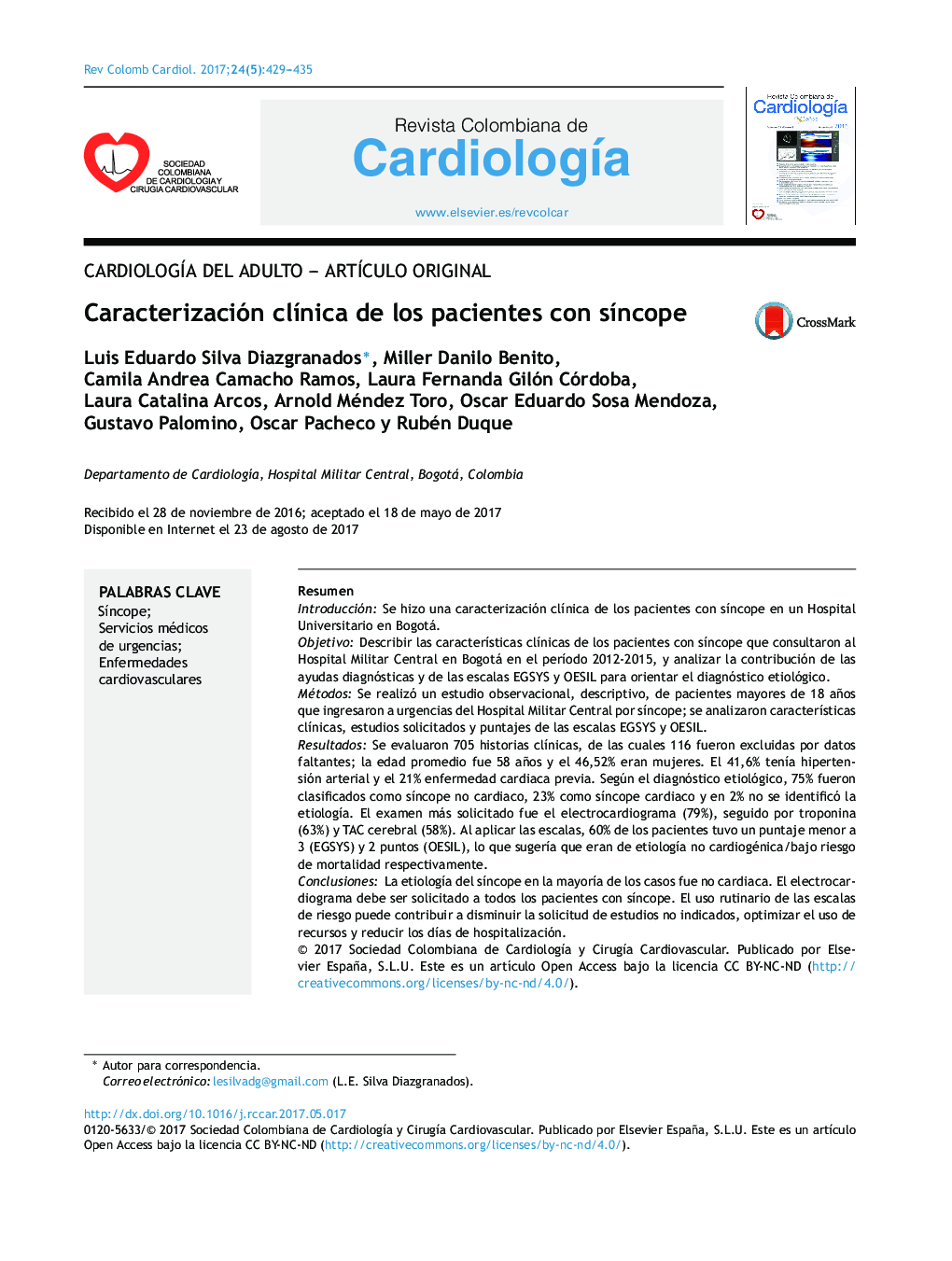| کد مقاله | کد نشریه | سال انتشار | مقاله انگلیسی | نسخه تمام متن |
|---|---|---|---|---|
| 5620402 | 1579018 | 2017 | 7 صفحه PDF | دانلود رایگان |

ResumenIntroducciónSe hizo una caracterización clÃnica de los pacientes con sÃncope en un Hospital Universitario en Bogotá.ObjetivoDescribir las caracterÃsticas clÃnicas de los pacientes con sÃncope que consultaron al Hospital Militar Central en Bogotá en el perÃodo 2012-2015, y analizar la contribución de las ayudas diagnósticas y de las escalas EGSYS y OESIL para orientar el diagnóstico etiológico.MétodosSe realizó un estudio observacional, descriptivo, de pacientes mayores de 18 años que ingresaron a urgencias del Hospital Militar Central por sÃncope; se analizaron caracterÃsticas clÃnicas, estudios solicitados y puntajes de las escalas EGSYS y OESIL.ResultadosSe evaluaron 705 historias clÃnicas, de las cuales 116 fueron excluidas por datos faltantes; la edad promedio fue 58 años y el 46,52% eran mujeres. El 41,6% tenÃa hipertensión arterial y el 21% enfermedad cardiaca previa. Según el diagnóstico etiológico, 75% fueron clasificados como sÃncope no cardiaco, 23% como sÃncope cardiaco y en 2% no se identificó la etiologÃa. El examen más solicitado fue el electrocardiograma (79%), seguido por troponina (63%) y TAC cerebral (58%). Al aplicar las escalas, 60% de los pacientes tuvo un puntaje menor a 3 (EGSYS) y 2 puntos (OESIL), lo que sugerÃa que eran de etiologÃa no cardiogénica/bajo riesgo de mortalidad respectivamente.ConclusionesLa etiologÃa del sÃncope en la mayorÃa de los casos fue no cardiaca. El electrocardiograma debe ser solicitado a todos los pacientes con sÃncope. El uso rutinario de las escalas de riesgo puede contribuir a disminuir la solicitud de estudios no indicados, optimizar el uso de recursos y reducir los dÃas de hospitalización.
IntroductionA clinical profile was constructed on patients with syncope in a Bogota University Hospital.ObjectiveTo describe the clinical characteristics of patients with syncope that were seen in the Hospital Militar Central in Bogota in the period 2012-2015, as well as to analyse the contribution of diagnostic aids and the Evaluation of Guidelines in Syncope Study (EGSYS) and the Lazio epidemiological syncope Observation (OESIL) scores in order to determine the aetiological diagnosis.MethodsA descriptive observational study was performed on patients over 18 years admitted to the Emergency Department of the Hospital Militar Central due to syncope. An analysis was carried out on the clinical characteristics, examinations requested, and the scores on the EGSYS and OESI L scales.ResultsA total of 705 clinical histories were evaluated, of which 116 were excluded due to lack of data. The mean age was 58 years, and 46.52% were women. Arterial hypertension was observed in 41.6%, and 21% had a previous heart disease. According to the aetiological diagnosis, 75% were classified as non-cardiac syncope, 23% as cardiac syncope, and 2% of unknown origin. The most requested examination was the electrocardiogram (79%), followed by troponin (63%), and a computed tomography brain scan (58%). On applying the scales, 60% of the patients had a score of less than 3 (EGSYS) and 2 points (OESIL), which suggested that they were of non-cardiogenic origin/low mortality risk, respectively.ConclusionsThe origin of syncope in the majority of cases was non-cardiac. An electrocardiogram must be requested on all patients with syncope. The routine use of risk scales can contribute to reducing the number of non-indicated examinations, as well as optimise the use of resources and reduce hospital stay.
Journal: Revista Colombiana de CardiologÃa - Volume 24, Issue 5, SeptemberâOctober 2017, Pages 429-435